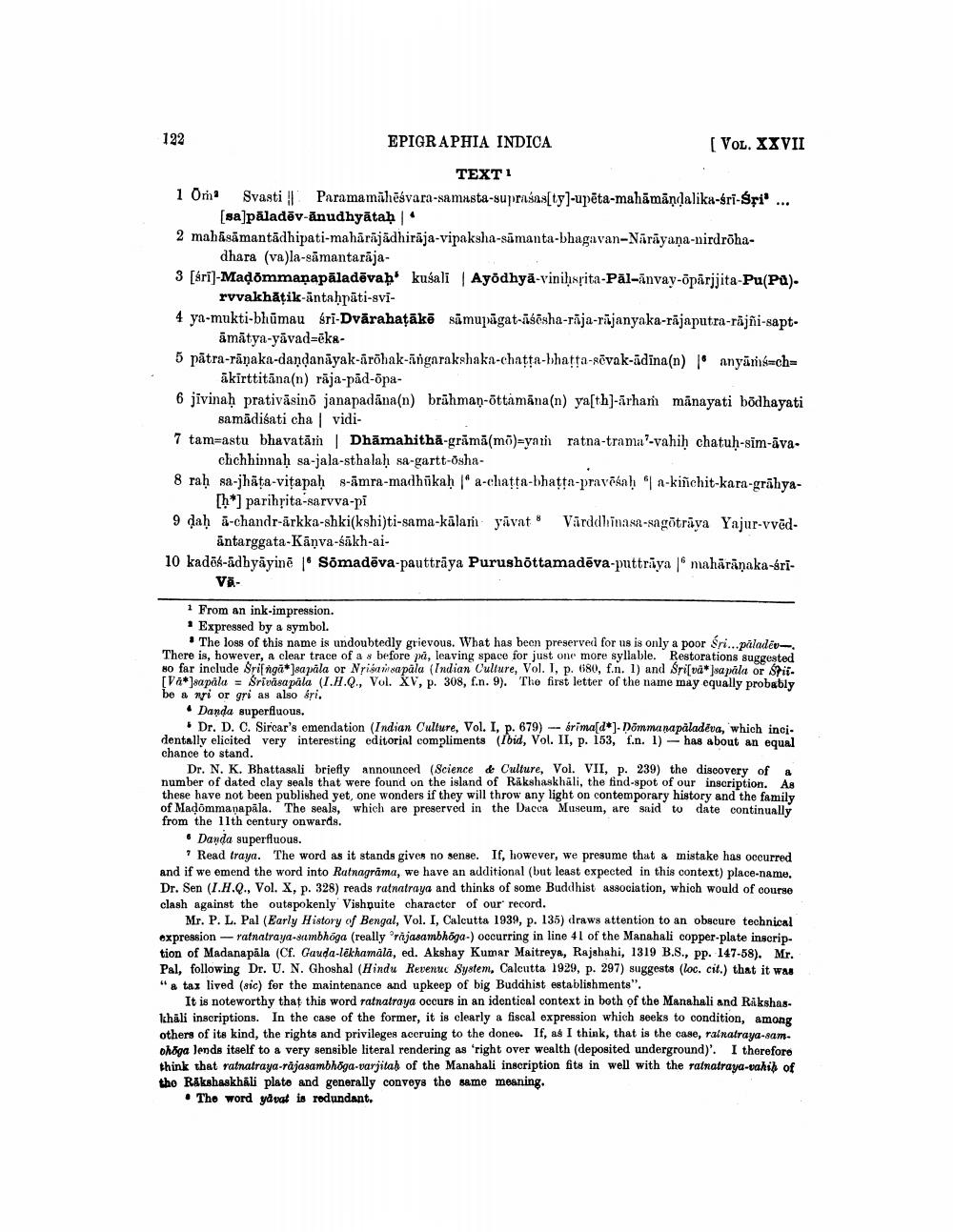________________
122
EPIGRAPHIA INDICA
(VOL. XXVII
TEXT1 1 Om Svasti Paramamahēsvara-samasta-supraśns[ty]-upēta-mahāmāndalika-sri-Śşi' ...
[sa]pāladēv-anudhyātaḥ 2 mahasāmantādhipati-maharajadhirāja-vipaksha-sāmanta-bhagavan-Nārāyaṇa-nirdrõha
dhara (va)la-sāmantarāja3 [árī)-Maçõmmanapāladēvah' kusali | Ayodhya-viniharita-Păl-ānvay-õpārjjita-Pu(Pa).
rvvakhăţik-āntahpāti-svi4 ya-mukti-bhūmau sri-Dvärahatākā sāmupāgat-āsēsha-rāja-rajanyaka-rājaputra-rajñi-sapt
āmātya-yāvad=ēks5 pātra-rāņaka-dandanāyak-arõhak-angarakshaka-chatta-bhatta-sēvak-adina(n) l' anyams=ch=
äkirttitāna(n) rāja-păd-opa6 jivinaḥ prativasino janapadana(n) brāhmaṇ-õttamāna(n) ya[th]-arhan manayati bödhayati
samādisati cha | vidi7 tam=astu bhavatām Dhāmahithă-grāmā(mö)=yari ratna-trama'-vahih chatuh-sim-āva.
chchhinnaḥ sa-jala-sthalah sa-gartt-osha8 raḥ sa-jhăța-vitapah s-amra-madhūkaḥ 1" a-chatta-bhatta-pravēlah la-kiñchit-kara-grāhya
[h*] parihrita-sarvva-pi 9 dah a-chandr-arkka-shki(kshi)ti-sama-kalari yavat Värddhinasa-sagotriva Yajur-vvēd
āntarggata-Kāņva-sākh-ai10 kados-adhyāyinē Somadēva-pauttrāya Purushottamadēva-puttriya | mahärāņaka-gri
V
1 From an ink-impression.
Expressed by a symbol.
• The loss of this name is undoubtedly grievous. What has been preserved for us is only a poor Sri...paladin There is, however, a clear trace of a s before pă, leaving space for just one more syllable. Restorations suggested Ho far include Srif ngajeapila or Nyišavinapala (Indian Culture, Vol. 1, p. 680, f.n. 1) and Silva*]sapāla or Stii. [Va*]sa pala = Srivasapala (1.H.Q., Vol. XV, p. 308, f.n. 9). The first letter of the name may equally probably be a ni or gri as also sri.
Danda superfluous.
Dr. D. C. Sircar's emendation (Indian Culture, Vol. I, p. 679) - Srima[do]. Dommanapaladiva, which inci. dentally elicited very interesting editorial compliments (Ibid, Vol. II, p. 153, f.n. 1) - has about an equal chance to stand.
Dr. N. K. Bhattasali briefly announced (Science & Culture, Vol. VII, p. 239) the discovery of 4 number of dated clay seals that were found on the island of Rakshaskhali, the find-spot of our inscription. As these have not been published yet, one wonders if they will throw any light on contemporary history and the family of Madömmanapala. The seals, which are preserved in the Dacca Museum, are said to date continually from the 11th century onwards.
• Danda superfluous.
? Read traya. The word as it stands gives no sense. If, however, we presume that a mistake has occurred and if we emend the word into Ratnagrama, we have an additional (but least expected in this context) place-name. Dr. Sen (I.H.Q., Vol. X, p. 328) reads ratnatraya and thinks of some Buddhist association, which would of course clash against the outspokenly Vishnuite character of our record.
Mr. P. L. Pal (Early History of Bengal, Vol. I, Calcutta 1939, p. 135) draws attention to an obscure technical expression - ratnatraya-sambhöga (really Prajasambhoga-) occurring in line 41 of the Manahali copper-plate inscription of Madanapāla (Cf. Gauda-lēkhamalā, ed. Akshay Kumar Maitreya, Rajshahi, 1319 B.S., pp. 147-58). Mr. Pal, following Dr. U. N. Ghoshal (Hindu Revenue System, Calcutta 1929, p. 297) suggests (loc. cit.) that it was "a tax lived (sic) for the maintenance and upkeep of big Buddhist establishments".
It is noteworthy that this word ratnatraya occurs in an identical context in both of the Manahali and RakshasIchali inscriptions. In the case of the former, it is clearly a fiscal expression which seeks to condition, among others of its kind, the rights and privileges accruing to the doneo. If, as I think, that is the case, ralratraya-samohöga lends itself to a very sensible literal rendering as 'right over wealth (deposited underground)'. I therefore think that ratnatraya-rajasambhoga-varjitah of the Manahali inscription fits in well with the rainatraya-vahil of tho Rakshaskhali plate and generally conveys the same meaning,
• The word yavat is rodundant.




